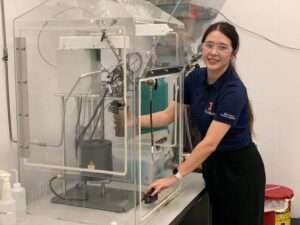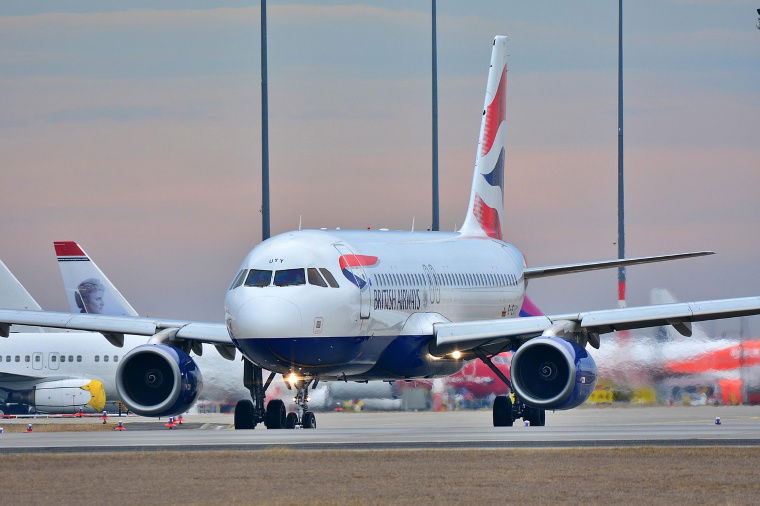Researchers at the University of Illinois Urbana-Champaign (U of I) have successfully converted food waste into a form of sustainable aviation fuel (SAF) that they say meets industry standards without relying on fossil fuel blends.
The team suggests that their approach, which helps reduce dependence on fossil fuels for aviation applications and redirects otherwise discarded food waste from landfills where it generates more greenhouse gases, could help the aviation industry meet its “ambitious” goal of net-zero carbon emissions by 2050.
According to a statement detailing the innovative approach, the researchers utilized a process called hydrothermal liquefaction (HTL), which employed a thermochemical reaction to convert ordinary food waste into a basic biocrude oil. This process is similar to how natural processes create crude oil, which is used to make a wide range of products, including automotive and aviation fuels.
“HTL basically mimics the natural formation of crude oil in the Earth,” explained the study’s lead author, Sabrina Summers, from the U of I. “It uses high heat and pressure to convert wet biomass into a biocrude oil.”
Summers, who recently graduated with a doctoral degree from the Department of Agricultural and Biological Engineering (ABE), part of the College of Agricultural, Consumer and Environmental Sciences and The Grainger College of Engineering at U. of I, said the goal of their research was to upgrade the biocrude oil generated during the HTL process into transportation fuels “that can go directly into existing energy infrastructure.”
 Sabrina Summers, from the University of Illinois, demonstrates hydrotreating biocrude oil derived from food waste. Image Credit: Marianne Stein.
Sabrina Summers, from the University of Illinois, demonstrates hydrotreating biocrude oil derived from food waste. Image Credit: Marianne Stein.
The first step in the team’s process involved removing impurities from the biocrude oil. These unwanted contaminants included things like moisture, salt, and ash. Next, Summers and colleagues employed another process, called catalytic hydrotreating, to remove additional unwanted components of the biocrude oil, such as sulfur, oxygen, and nitrogen. The team stated that upon completion of these steps, the remaining biocrude was almost entirely composed of the hydrocarbons required to produce jet fuel.
The final step to make viable SAF involved catalyzing the hydrocarbons. According to the team’s statement, they tested several options before settling on cobalt molybdenum as the “most effective” catalyst to drive the needed chemical reactions. During the hydrotreatment portion, the research team also fine-tuned the catalyst and hydrogen loads, temperature, and overall retention time until they achieved the optimal conditions for producing the desired fuel.
Once the conversion process was completed, the team said they tested their final batch of SAF against the “rigorous standards” for quality and purity set by the American Society for Testing and Materials (ASTM) and the Federal Aviation Administration. As hoped, the team said their sample passed “Tier Alpha and Beta prescreening tests” and successfully met “all specifications for conventional jet fuel.” Notably, the team said their fuel met these standards without the need for any additives or blending with fossil fuels.
When discussing the versatility of their biocrude jet fuel, the team noted that the ability to use food waste as a fuel source is critical, since over 30% of the world’s food is wasted every year “at all levels” of the supply chain. Although the food waste for experiments came from a nearby food processing facility, Summers’ team said that the HTL process can be applied to other organic waste products. These include otherwise discarded materials, such as biowaste, algal blooms, sewage sludge, swine manure from farming, and other forms of agricultural residue that are high in base hydrocarbons.
“To meet the aviation industry’s goals to decarbonize jet fuel, we need many different renewable sources, and agriculture is going to play a critical role in terms of providing the feedstocks,” explained ABE professor and the study’s corresponding author, Yuanhui Zhang.
When discussing the potential applications of their research, Zhang noted that their work has helped solve the scientific and engineering problems associated with converting food waste into usable jet fuel, and it is now time for industry to “step in.”
“The process can be applied to other types of oils for SAF,” he explained. “It can also replace other materials, such as petroleum-derived compounds, for making plastics. This has huge potential for business opportunities and economic development.”
To highlight potential areas that could benefit from this type of biocrude-to-jet-fuel process, Zhang developed an index to measure circular bioeconomy, in which he said SAFs provide a valuable contribution to circularity.
“In a linear economy, we just produce something, use it, and throw it away,” he explained. “In this project, we take the waste and recover the energy and materials to make a usable product. This fills a missing link in the circular paradigm.”
The paper, “From food waste to sustainable aviation fuel: cobalt molybdenum catalysis of pretreated hydrothermal liquefaction biocrude,” was published in Nature Communications.
Christopher Plain is a Science Fiction and Fantasy novelist and Head Science Writer at The Debrief. Follow and connect with him on X, learn about his books at plainfiction.com, or email him directly at christopher@thedebrief.org.


